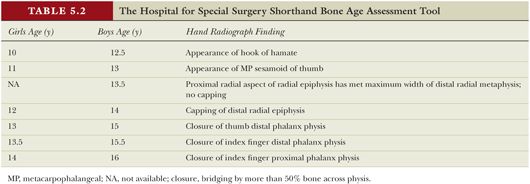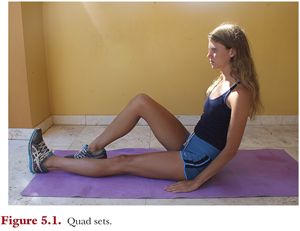
The extent of the ACL injury is an important determinant of which children can be considered for nonoperative management. In a tibial spine avulsion injury, the fracture of the intercondylar eminence is classified by severity of the displacement and angulation, which guides management. A nondisplaced or minimally displaced tibial spine avulsion injury can be treated nonoperatively with positive results, whereas more severely displaced and angulated avulsion injuries require arthroscopic reduction and internal fixation regardless of the child’s age or skeletal maturity.8 Similarly, the location of the ACL tear and the amount of ligament torn play a large role in differentiating which patients are candidates for nonoperative therapy. Patients with partial tears of the ACL, particularly those compromising less than 50% of the diameter of the ligament, have been shown to be promising candidates for nonsurgical management. Kocher et al.9 performed a prospective cohort study on 45 skeletally mature and immature patients 17 years of age or younger to assess the functional outcome after partial ACL tears in children and adolescents treated nonoperatively. Of the 45 patients treated with a nonoperative structured rehabilitation program and followed for at least 2 years, only 14 of the patients (31%) underwent subsequent reconstruction due to symptoms of instability or episodes of reinjury. The study found that the need for reconstruction after initial nonoperative treatment was significantly associated with tears greater than 50% of the thickness of the ligament, tears that were predominantly posterolateral in location, and patients older in chronologic and skeletal age. Therefore, the research advocates for consideration of nonoperative management for ACL tears in children and adolescents 14 years of skeletal age or less with less than 50% tear of the ligament.9 While assessing the degree of the ACL tear through the physical examination and MRI studies, it is important to evaluate the knee joint as a whole to determine if there has been damage to any other structures. Many studies have evaluated skeletally immature patients with ACL tears and concomitant tears to the meniscus and have found poor outcomes with nonoperative treatment.10 Therefore, the nonoperative approach is best suited for those with isolated injuries to the ACL with no other ligamentous or cartilage involvement.
Compliance with both the rehabilitation program and willingness to modify activity is essential for a patient to be successful with nonoperative treatment. Many children and adolescents with ACL injuries are competitive athletes who desire to pursue sports that involve cutting and pivoting movements for a lifetime. The modification and limitation of certain activities is temporary, with the hope that proper rehabilitation can nurture the patient back into their desired activities without hindrance. However, every patient should know that both nonoperative and operative treatment carry the risk of not returning to high-risk activities, such as cutting and pivoting sports. The benefit of each treatment far outweighs the risk, as the patient would be unable to engage in such activities without one treatment or the other. A prospective cohort study by Moksnes et al.11 investigated changes in functional performance following a nonoperative treatment algorithm for ACL injuries in skeletally immature children 12 years and younger. A majority (78%) of the 36 children treated nonoperatively remained ACL deficient with adequate knee function. Ninety-one percent of the ACL-deficient children reported consistent participation in pivoting sports and/or physical education classes in school.11 These patients did also report changing their primary sport to one that does not pose a risk to the ACL, which can be attributed to apprehension of reinjury.
The nonsurgical approach is most effective in a highly compliant patient with a partial ACL tear and no additional intra-articular injury who is willing and able to decrease their activity level during a given period of time. Despite these generalizations, every young patient should be well informed about the nonoperative treatment option and the pros and cons of this management program if faced with an ACL injury.
INDICATIONS FOR ADOLESCENT ANTERIOR CRUCIATE LIGAMENT RECONSTRUCTION AFTER NONOPERATIVE MANAGEMENT
Adolescent ACL reconstruction may be advised if there is persistent knee instability, multiple giving-way episodes, a secondary injury, or an unacceptable lowering of the patient’s activity level after nonoperative management has been maximized. Patients who experience repeated instability episodes during a course of nonoperative treatment have demonstrated an increased risk of accelerated joint disease secondary to the instability.12
CONTRAINDICATIONS TO NONOPERATIVE MANAGEMENT
Tears involving more than 50% of the diameter of the ACL have demonstrated unsatisfactory outcomes with conservative management, and some of these tears have progressed to a complete tear when initial reconstruction was not performed.13 Full-thickness tears of the ACL treated with nonoperative management carry the risk of increased intra-articular damage in the form of meniscal tears and damage to the cartilage. Although animal studies have shown that there is increased healing potential of an injured ACL in the skeletally immature compared with adults,14 nonoperative management of complete tears generally has a poor prognosis when compared to the surgical reconstruction options available today.
As discussed earlier, many children who have sustained an ACL injury will also have coexistent meniscal damage, which is a relative contraindication to nonoperative management. In addition, a patient who is poorly compliant will not succeed with nonoperative treatment, as it requires complete dedication and discipline. Poor compliance will put the young individual at significant risk of further meniscal injury or articular cartilage damage.
A functionally unstable knee, as evidenced by multiple episodes of giving out, has been shown to have poor results with nonoperative treatment. Children approaching skeletal maturity and with little growth remaining should go straight to reconstruction without delay if they are experiencing instability symptoms.
AUTHORS’ PREFERRED NONOPERATIVE TREATMENT
After initial injury to the ACL, rehabilitation is divided into three subsequent phases. The initial phase is directed at resolving knee impairments related to swelling and range-of-motion (ROM) deficits. The second phase aims to restore muscle strength and adequate neuromuscular responses. The goal of the third phase is to equip patients with a series of exercises and stretches that can be continued indefinitely as preventive medicine. Active rehabilitation will not be entirely the same for every child or adolescent with an ACL injury, but there are fundamental principles that will be consistent throughout the treatment.
Phase 1: Control Swelling, Restore Range of Motion, Normalize Gait
Phase 1 aims to control pain and swelling, restore ROM to the knee joint, improve flexibility, normalize gait mechanics, and establish good quadriceps activation. The patient should elevate and apply ice immediately after injury with an elastic wrap to control the initial swelling. Ice can be applied for 20-minute periods multiple times throughout the day. Always maintain one layer between the ice and the skin, such as a cloth or paper towel, to prevent damage to the skin. If the entire leg is swollen, elevating the leg and using elastic stockings can help to decrease the general swelling. Anti-inflammatory medications are also very beneficial immediately after injury, and the physician will prescribe their medication of choice if they see fit. The primary goal immediately after the injury is to decrease the swelling so that the patient can work toward regaining full ROM. During the early period of immobilization, it is crucial to avoid any pivoting or twisting motions of the knee that might lead to instability and giving out. It is important to alert the physician if the child has any episodes of knee buckling. The knee is extremely unstable immediately after injury and the thigh muscles can become very weak. It may be difficult to support the weight of the body when walking during the first few days, which is why most children and adolescents require crutches to avoid full weight bearing. The knee can also be protected with the use of a knee brace to aid in immobilization. Although the knee brace is a useful aid, it is not sufficient when used without intentional restriction of activities. A study by Graf et al.10 showed that bracing alone does not prevent meniscal tears in the absence of activity modification, making it imperative that the patient does not try to return to weight bearing or activity too soon. The experienced physician will monitor progression and determine when the patient can wean from two crutches to one crutch, and then from one crutch to walking without aid. The single crutch is always held on the opposite side of the injured knee. Patients may progress to walking without aid when they are able to walk without a limp and with no pain. If the patient cannot demonstrate pain-free normal walking mechanics, they cannot walk without crutches. Every pediatric or adolescent with an injury to the ACL will progress at their own rate, as swelling can remain anywhere from days to weeks, so there is no exact time frame that one can expect to follow during this phase. Once the swelling has diminished and the pain subsides, a stretching and strengthening program is of utmost importance in regaining the full motion and strength of the knee joint. Rehabilitation with an experienced physical therapist is important in ensuring that the pediatric or adolescent patient is performing the exercises and stretches properly and with enough frequency.
During phase 1, there are ROM and strength exercises that can be gradually introduced as the swelling decreases to initiate the return to full strength. The swelling and ROM deficits must be resolved before progressing to phase 2. An adolescent patient can use an exercise bike machine daily at a very low effort level for 10 minutes to increase blood flow and aid in ROM recovery. The focus of this acute phase is on maintaining muscle tone in the quadriceps muscle, which will help straighten the knee, as quadriceps muscle weakness has been associated with ACL injury. Many studies have demonstrated that if an adequately designed rehabilitation program is not performed soon after the injury, strength in the quadriceps muscle group is difficult to recover.15 In another study, Zebis et al.16 emphasized the importance of the hamstring muscles in stabilizing the knee in order to restore full knee flexion after an injury to the ACL. The Nordic hamstring exercise described in phase 2 will increase eccentric hamstring muscle strength, which is important as the hamstrings help the ACL during stopping and jumping.
Strength Exercises during Phase 1: Perform These Exercises Once Daily during the Acute Phase
Quad Sets: Quad sets will help build and maintain strength in the muscles on top of the thigh. Sit on the floor with the injured leg straight out in front of the body. Tighten the muscles on top of the thigh by pressing the back of the knee flat down to the floor. Hold for about 6 seconds, then rest for up to 10 seconds. Perform 1 set of 8 to 12 repetitions, increasing to 2 sets as the phase progresses. If there is any discomfort under the knee, place a small towel beneath the knee during the exercise (Fig. 5.1).




